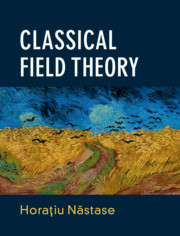Book contents
- Frontmatter
- Dedication
- Contents
- Preface
- Acknowledgements
- Introduction
- Part I General Properties of Fields; Scalars and Gauge Fields
- 1 Short Review of Classical Mechanics
- 2 Symmetries, Groups, and Lie algebras; Representations
- 3 Examples: The Rotation Group and SU(2)
- 4 Review of Special Relativity: Lorentz Tensors
- 5 Lagrangeans and the Notion of Field; Electromagnetism as a Field Theory
- 6 Scalar Field Theory, Origins, and Applications
- 7 Nonrelativistic Examples:WaterWaves and Surface Growth
- 8 Classical Integrability: Continuum Limit of Discrete, Lattice, and Spin Systems
- 9 Poisson Brackets for Field Theory and Equations of Motion: Applications
- 10 Classical Perturbation Theory and Formal Solutions to the Equations of Motion
- 11 Representations of the Lorentz Group
- 12 Statistics, Symmetry, and the Spin-Statistics Theorem
- 13 Electromagnetism and the Maxwell Equation; Abelian Vector Fields; Proca Field
- 14 The Energy-Momentum Tensor
- 15 Motion of Charged Particles and ElectromagneticWaves; Maxwell Duality
- 16 The Hopfion Solution and the Hopf Map
- 17 Complex Scalar Field and Electric Current: Gauging a Global Symmetry
- 18 The Noether Theoremand Applications
- 19 Nonrelativistic and Relativistic Fluid Dynamics: Fluid Vortices and Knots
- Part II Solitons and Topology; Non-Abelian Theory
- Part III Other Spins or Statistics; General Relativity
- References
- Index
11 - Representations of the Lorentz Group
from Part I - General Properties of Fields; Scalars and Gauge Fields
Published online by Cambridge University Press: 04 March 2019
- Frontmatter
- Dedication
- Contents
- Preface
- Acknowledgements
- Introduction
- Part I General Properties of Fields; Scalars and Gauge Fields
- 1 Short Review of Classical Mechanics
- 2 Symmetries, Groups, and Lie algebras; Representations
- 3 Examples: The Rotation Group and SU(2)
- 4 Review of Special Relativity: Lorentz Tensors
- 5 Lagrangeans and the Notion of Field; Electromagnetism as a Field Theory
- 6 Scalar Field Theory, Origins, and Applications
- 7 Nonrelativistic Examples:WaterWaves and Surface Growth
- 8 Classical Integrability: Continuum Limit of Discrete, Lattice, and Spin Systems
- 9 Poisson Brackets for Field Theory and Equations of Motion: Applications
- 10 Classical Perturbation Theory and Formal Solutions to the Equations of Motion
- 11 Representations of the Lorentz Group
- 12 Statistics, Symmetry, and the Spin-Statistics Theorem
- 13 Electromagnetism and the Maxwell Equation; Abelian Vector Fields; Proca Field
- 14 The Energy-Momentum Tensor
- 15 Motion of Charged Particles and ElectromagneticWaves; Maxwell Duality
- 16 The Hopfion Solution and the Hopf Map
- 17 Complex Scalar Field and Electric Current: Gauging a Global Symmetry
- 18 The Noether Theoremand Applications
- 19 Nonrelativistic and Relativistic Fluid Dynamics: Fluid Vortices and Knots
- Part II Solitons and Topology; Non-Abelian Theory
- Part III Other Spins or Statistics; General Relativity
- References
- Index
Summary
We find the Lie algebra of the Lorentz group and then extend it to the Poincaré group, the group of symmetries of flat space. We then point out that, as SU(2) is the universal cover of SO(3), for the Lorentz group SO(3,1) the universal cover is SL(2,C).We then use Wigner's method, using the little group in four dimensions, to find massive and massless representations of the Lorentz and Poincaré groups. We thus find various possible fields, corresponding to these representations. We end by explaining how SL(2,C) is the universal cover of SO(3,1).
Keywords
- Type
- Chapter
- Information
- Classical Field Theory , pp. 97 - 107Publisher: Cambridge University PressPrint publication year: 2019

